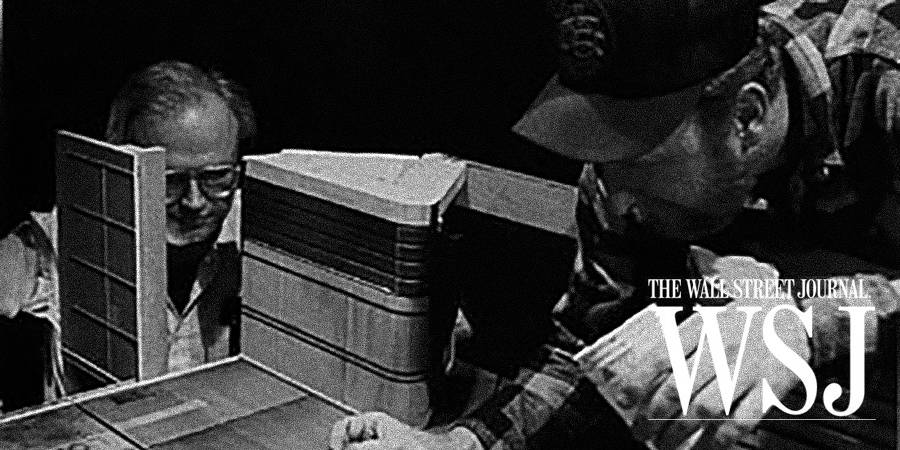 Kris Van de Sande
Kris Van de Sande Steve Sansweet mentioned this Wall Street Journal article that he wrote about Star Tours back in January 1987, and staff researchers Alex Newborn and Brian Curran promptly tracked down a copy.
Creating Fantasies: Disney’s ‘Imagineers’ Build Space Attraction Using High-Tech Gear — Star Tours Heralds New Type Of Show at Theme Parks
Collaborating With Lucas
By Stephen J. Sansweet, The Wall Street Journal
Jan 6, 1987ANAHEIM, Calif. — Scores of workmen bustle about the cavernous black-walled building, making electrical connections here, checking hydraulic pressure there. But sparks from welders’ torches and the smell of fresh paint don’t seem to put off a group of men and women who are about to take a test ride in the nation’s newest, top-secret spacecraft, the Star-Speeder 3000.
Five outer doors pop open. Then it is a short walk over a wide gangplank to the sleek white metallic craft itself. Seat belts fastened, the passengers listen to a taped spiel from the Star Tours travel agency. A corrugated barrier in the front of the craft descends, and the pilot — a very animated robot named Rex — reveals that it is his first flight, too. But it is too late to leave. The craft is rising, then lurching forward into a 4 1/2-minute trip through the galaxy, pitching and yawing to avoid the meteorites and laser cannon blasts that are visible through the windows.
Star Tours, which weds giant aircraft simulators with film from the Star Wars world of George Lucas, is the newest theme-park show from a team of engineers, artists and storytellers whom Walt Disney dubbed “imagineers.” The crew plays a major role in Walt Disney Co.’s continuing success in the increasingly competitive outdoor-attraction business.
But the group’s latest creation — which cost nearly $32 million and opens at Disneyland Friday — is more than just a thrill ride with a storyline. It heralds a new generation of outdoor amusement and theme park shows made of high-tech hardware that can be transformed into different attractions quickly and relatively cheaply by changing the software and facades.
“In the old days, if Walt didn’t like something, he tore it down and started over or made major modifications,” says Robert Develle, the vice president for engineering of the Walt Disney Imagineering division. “The risks are a lot greater today, along with the costs.” Also, a more sophisticated public visits parks today, he says, and it needs to be lured back with constant additions and upgrading of attractions. Already, Imagineering has twice modified an older show, Country Bear Jamboree, by reprogramming oversized robot animals and changing costumes and props. <snip>
What eventually became Star Tours was under consideration for more than six years. Originally it was to have been an “interactive” ride — guests would have controlled where they went — based on a Disney science-fiction film, “The Black Hole.” But that would have cost at least $50 million, and the film was a flop. Despite initial reluctance to go outside the company, corporate officials approached Mr. Lucas, a longtime Disney fan.
At the same time, Charles R. Bright, the vice president for concept development, was scouring the world for new technology. He found a British company, Rediffusion Simulation Ltd., that had rigged a large aircraft simulator — the kind used to train jumbo-jet pilots — with speed scene films that seemed to show the outside world whizzing by. The 13-ton simulator could rise and fall or dive and roll as much as 35 degrees even when fully loaded. With the right combination of film and motion, passengers felt as though they had been on an actual flight.
The simulators cost about $500,000 each. “But the sweet thing is you can change out the software without having to do a major brick and mortar job,” says Mr. Bright. “It’s like changing the script and sets at Radio City Music Hall when people get bored with the show.” Mr. Lucas agreed that his company would do the film, with Imagineering designing the physical setting and both working out the story line.
There were many compromises and changes along the way. The initial concept would have taken 20 minutes; it was cut to 3 1/2, then increased by a minute when those involved decided that the public would feel cheated by such a short ride after waiting several hours to get in. Even though there are four simulators, only 1,660 people an hour can go through Star Tours, about a third the capacity of other major Disneyland attractions. But waiting throngs should be mollified by a walk-through pre-show starring C-3PO and R2-D2, portrayed by real robots, and robot geese that endlessly repair other robots and exchange wisecracks.
Conceptually, Mr. Lucas wanted to steer clear of war themes, although there are some whiz-bang battles that rock the cabin. The personality of the robot pilot was changed from crazy to simply inexperienced and nervous. “Everyone can relate to first-time drivers,” says Thomas J. Fitzgerald, the show’s writer and producer.
Months of testing with the simulator led to the discovery that if movements in the film and cabin could be perfectly synchronized — and a particular swaying movement could be programmed out — the nausea that bothers many people on roller coasters could be avoided without losing any of the thrill. Mr. Fitzgerald, who suffers motion sickness easily, was the guinea pig. His verdict: “It’s intense, but just enough.”
Mistakes were made. The original $30 million budget (including a 10% contingency fund) didn’t include a new facade for the 20-year-old building where Star Tours is housed. But when the roof had to be raised to accommodate the movement of the simulators, the exteriors needed extensive reworking. And just a few weeks ago, Mr. Lucas decided that the sound system inside the theater cabins needed to be improved at a cost of an additional $100,000.
The complete version of this article may be purchased online at wallstreetjournal.com for a charge of $4.95.